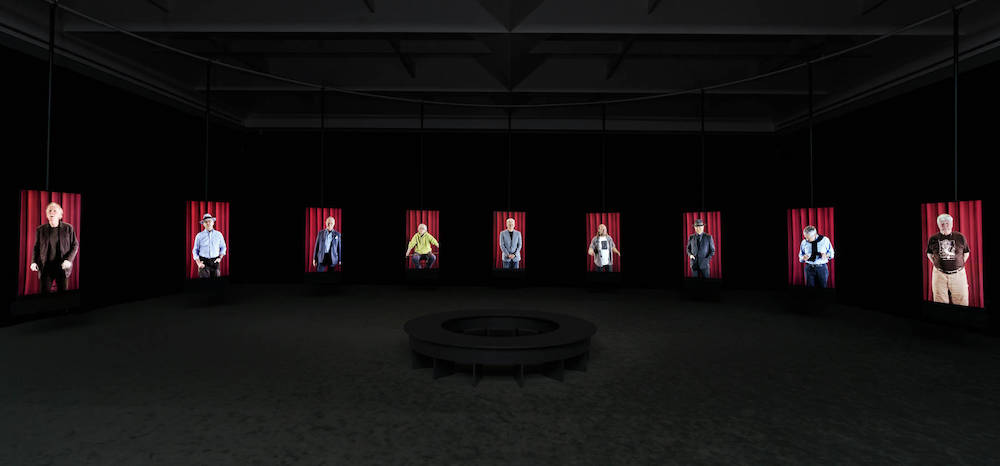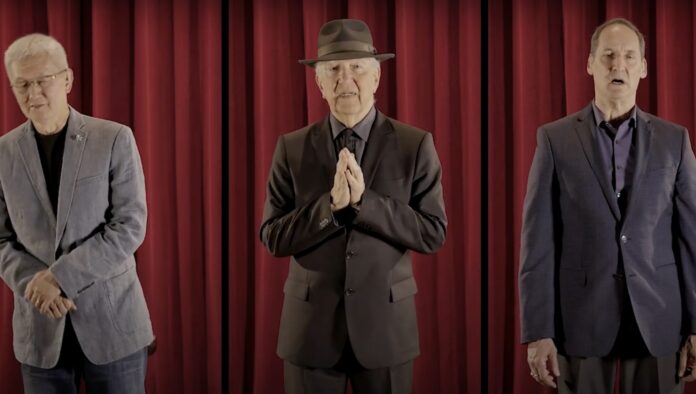As part of the exhibition “Experience Leonard Cohen” (through February 13, 2022 at the Contemporary Jewish Museum, read our full review here), Senior Curator Heidi Rabben presents Candice Breitz’s “I’m Your Man (A Portrait of Leonard Cohen)” from 2017. As the breathtaking video installation ruminates on Cohen’s music, the work more importantly showcases individuals within a collective and explores the vulnerability and grace of silence and incompleteness.
As Breitz has previously isolated, omitted, and re-staged dialogue from Hollywood films, or the dialogue-like relationship within popular music compositions, the artist dissects the vocals from Cohen’s 1988 album I’m Your Man. Spread between two galleries, Breitz presents session recordings of professional and amateur singers with in-ear monitors, such the singers hear the music while viewers do not.
In the first gallery, Breitz features a large single-channel projection of the Shaar Hashomayim Synagogue Choir—the congregation that Cohen belonged to throughout his life and who performed the back-up vocals for the musician’s last album. As the video documents the nine all-male choir members lusciously singing the background vocals, Breitz has also mic’d the room to record ambient noise, like the sound of musicians turning the pages of the score and the conductor counting the music, things usually omitted in recording sessions.
Devoid of the instrumentals and lead vocals, the choral’s intermittent singing becomes the video’s focus, an inversion the usual foreground-background relationship in most music. Like hearing only one side of a conversation, the relative silence makes viewers acutely aware of the work’s incompleteness.
In the second gallery, Breitz presents 18 sexagenarian and septuagenarian men approximating the musician’s iconic gravely voice and phrasing. With singers dressed in a range of clothing, including tee-shirts and jeans, suits, and a dress, Breitz presents Cohen’s wide appeal and an expansive notion of “masculinity.” The red velvet curtain hanging behind the singers creates a sparse theatrical setting, a reminder that they are performing for the camera, some hamming it up and others more reserved.

Presented on vertically mounted monitors, videos line the gallery in an ellipse. As video portraits that are about life-sized and positioned at about eye-height, Breitz establishes a one-to-one encounter between viewers and the singers. With sound bars mounted beneath each monitor, when standing close viewers can intimately hear the individuals singing. In contrast, when seated in the center of the room, the work transforms into a complete surround-sound experience, highlighting the work as a collective, a grouping of an “every man.”
Some of the most poignant moments occur within the relatively silent moments of the videos that subtly display an unexpected sense of vulnerability, the awkwardness of relative silence, heightened by the fact that this is a musical recording. Waiting for their musical cue, the singers shift their weight and tap their hands to the music’s tempo to maintain the energy for their delivery. As they keep the beat to music through their bodies, the silence has a visual tempo.
Masterfully, Breitz creates a spatial experience, wherein moving deeper into the galleries, the videos and sound gradually unfold and inform each other. Moreover, the work operates as a generational metaphor, where the back-up coral of younger men support the elders as they sing the lead vocals. As the lyrics explore a nobility in love, loss, and resistance, Cohen also becomes a surrogate for individuals to express and perform the depths of emotion.
“EXPERIENCE LEONARD COHEN” runs through February 13 at the Contemporary Jewish Museum. More info here.




